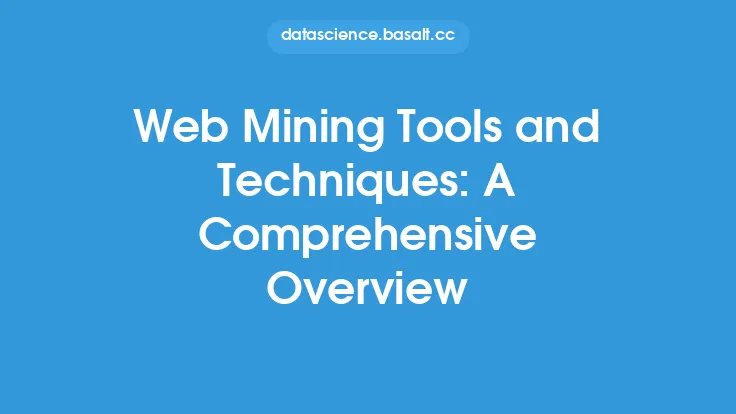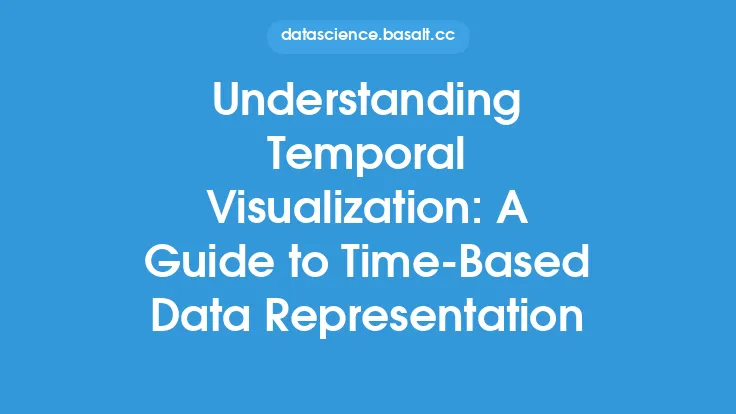Temporal visualization is a crucial aspect of data visualization that deals with the representation of time-based data. It involves the use of various techniques and tools to effectively communicate insights and patterns in data that vary over time. The primary goal of temporal visualization is to provide a clear and concise representation of time-series data, enabling users to understand trends, patterns, and relationships that may not be immediately apparent from the raw data.
Introduction to Temporal Visualization Concepts
Temporal visualization concepts are built around the idea of representing time-based data in a way that is easy to understand and analyze. This involves the use of various visual elements, such as lines, bars, and charts, to display data that varies over time. Some common concepts used in temporal visualization include time-series analysis, trend analysis, and pattern recognition. Time-series analysis involves the examination of data that is collected over time, often at regular intervals, to identify trends and patterns. Trend analysis involves the use of statistical techniques to identify patterns and trends in data, while pattern recognition involves the use of machine learning algorithms to identify complex patterns in data.
Techniques for Temporal Visualization
There are several techniques used in temporal visualization, each with its own strengths and weaknesses. Some common techniques include line charts, bar charts, and scatter plots. Line charts are often used to display time-series data, as they provide a clear and concise representation of trends and patterns over time. Bar charts are used to compare data across different time periods, while scatter plots are used to display the relationship between two variables over time. Other techniques, such as heat maps and treemaps, are used to display more complex data, such as hierarchical or categorical data.
Tools for Temporal Visualization
There are many tools available for temporal visualization, ranging from simple spreadsheet software to complex data visualization platforms. Some popular tools include Tableau, Power BI, and D3.js. Tableau and Power BI are business intelligence platforms that provide a range of data visualization tools, including temporal visualization capabilities. D3.js is a JavaScript library that provides a range of data visualization tools, including temporal visualization capabilities. Other tools, such as Matplotlib and Seaborn, are popular among data scientists and provide a range of temporal visualization capabilities.
Data Preparation for Temporal Visualization
Data preparation is a critical step in temporal visualization, as it involves the cleaning, processing, and transformation of data into a format that is suitable for visualization. This may involve handling missing data, removing outliers, and transforming data into a suitable format. Data preparation may also involve the use of data aggregation techniques, such as grouping and summarizing, to reduce the complexity of the data. Additionally, data preparation may involve the use of data normalization techniques, such as scaling and encoding, to ensure that the data is in a suitable format for visualization.
Best Practices for Temporal Visualization
There are several best practices that should be followed when creating temporal visualizations. These include keeping the visualization simple and intuitive, using clear and concise labels and titles, and avoiding clutter and unnecessary visual elements. Additionally, temporal visualizations should be interactive, allowing users to explore the data in more detail. This may involve the use of hover-over text, drill-down capabilities, and animation. Furthermore, temporal visualizations should be designed with the user in mind, taking into account their needs and goals.
Common Challenges in Temporal Visualization
There are several common challenges that may be encountered when creating temporal visualizations. These include handling large datasets, dealing with missing or incomplete data, and visualizing complex or high-dimensional data. Additionally, temporal visualizations may be affected by issues such as data quality, data consistency, and data accuracy. To overcome these challenges, it is essential to have a good understanding of the data, as well as the techniques and tools used for temporal visualization.
Advanced Topics in Temporal Visualization
There are several advanced topics in temporal visualization, including the use of machine learning algorithms to identify complex patterns in data, the use of big data technologies to handle large datasets, and the use of virtual reality and augmented reality to create immersive temporal visualizations. Additionally, advanced topics may include the use of temporal visualization to analyze and visualize data from multiple sources, such as social media, sensors, and IoT devices. These advanced topics require a good understanding of the underlying concepts and techniques, as well as the tools and technologies used for temporal visualization.
Future Directions in Temporal Visualization
The field of temporal visualization is constantly evolving, with new techniques, tools, and technologies being developed all the time. Some future directions in temporal visualization include the use of artificial intelligence and machine learning to create more intelligent and interactive visualizations, the use of big data and cloud computing to handle large datasets, and the use of virtual and augmented reality to create more immersive and engaging visualizations. Additionally, future directions may include the development of new visualization tools and technologies, such as those that use gesture recognition, voice recognition, or other forms of human-computer interaction. As the field of temporal visualization continues to evolve, it is likely that we will see new and innovative ways of representing and interacting with time-based data.





